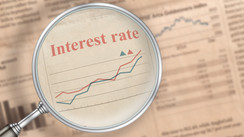Exploring the Federal Funds Rate
A key instrument in the Federal Reserve's arsenal for directing U.S. economic policy is the federal funds rate. Its impact is far-reaching, shaping everything from the annual percentage yields on savings accounts to the interest on your credit card balance. Thus, the federal funds rate effectively sets the monetary value within the U.S. economy.
The Operation of the Federal Funds Rate
Overseen by the Federal Open Market Committee (FOMC), the federal funds rate—known also as the fed funds rate or the federal funds target rate—is the guiding beacon for overnight lending among U.S. banks. This rate is set within a specified range, with an upper and lower limit.
Banks have capital, derived from customer deposits, that they utilize for extending credit and loans to their clientele. Regulatory bodies necessitate these banks to maintain a certain fraction of their total capital as reserves to ensure their stability and viability.
However, these capital reserves are in a state of constant flux due to the inflow and outflow of deposits, and loans being granted and paid back. This leads to continuous changes in their reserve requirements.
To maintain these requirements, banks often resort to borrowing funds overnight from other institutions. Similarly, they may find themselves in a position to lend out excess reserve capital. The federal funds rate acts as a guide for these transactions, setting the standard for the borrowing or lending of reserves.
Role of the Federal Funds Rate in Monetary Policy
The dual mandate that Congress has delegated to the Federal Reserve is the maintenance of stable prices throughout the economy, ensuring controlled inflation, and the fostering of maximum employment. The Federal Reserve is also tasked with the maintenance of moderate long-term interest rates and a stable financial system.
The fed funds rate is a critical instrument that enables the central bank to control the money supply in the economy. It directly influences what banks charge each other, which in turn affects the rates they impose on you and their other customers.
For example, the prime rate, a standard for consumer and business loans, aligns closely with changes to the fed funds rate. This is because banks pass on the fluctuating costs they incur to meet reserve requirements.
Increasing the fed funds rate allows the Fed to elevate short-term borrowing costs across the economy. This decreases the supply of credit, making loans more expensive for everyone, and can curb inflation by reducing the amount of money in circulation.
Conversely, reducing the fed funds rate has the opposite effect. It lowers short-term interest rates across the economy, increases the money supply, and makes credit more affordable. This can reverse periods of low or negative inflation and stimulate hiring as growth becomes less costly for companies.
The Federal Funds Rate's Impact on the Economy
The federal funds rate's influence extends beyond just interest rates. Its repercussions can be observed throughout the economy.
Anticipation of adjustments to the fed funds rate in the foreseeable future is a major determinant of Treasury yield movements, which form the basis for pricing many forms of business, government, and mortgage-backed credit.
Equity markets are highly susceptible to changes in the federal funds rate. When the Fed lowers rates, stock markets usually surge since the cost of borrowing for public companies decreases, making business expansion and profit growth more affordable. Conversely, when rates increase, equity markets may face more challenges as borrowing becomes pricier and lenders benefit from higher rates.
Deciphering the Federal Reserve's Interest Rate Decisions
The Federal Reserve alters the federal funds target rate range in response to the economy's current state. These adjustments aid the Fed in achieving conditions that satisfy their dual mandate: maintaining price stability and maximizing employment.
The FOMC adjusts interest rates upwards when the economy is overheating—excessive inflation—and lowers rates when the economy is sluggish—high unemployment.
The Federal Reserve’s monetary policy decisions are not made in a vacuum. They consider a wealth of data, such as gross domestic product (GDP), consumer spending, industrial production, along with major events such as a financial crisis, global pandemic, or significant terrorist attack.
The Federal Reserve comprises not just officious economists, analysts, and business experts, but it’s also sensitive to the shifting political environment.
About the Data
The tables you will encounter below outline the dates of the FOMC's interest rate changes, each change's size in basis points—abbreviated as bps—and the subsequent federal funds target rate range.
Interest rates are often measured in basis points. A single basis point equates to 1/100th of one percentage point, or 0.01%. As an example, a half a percentage point change in an interest rate equals 50 basis points.
Take note that prior to 1990, the Fed did not explicitly target a set federal funds rate. For those interested in earlier rate policies, we recommend referring to this Federal Reserve document made available through a Freedom of Information Act request.

The Federal Funds Rate Through History
The fed funds rate is not static. It ascends and descends in response to changes in the economy's health. Each year, the FOMC convenes eight policy meetings where they examine the economic terrain and decide whether to maintain the current fed funds rate or adjust it.
In the past 50 years, the federal funds rate has fluctuated between 0% and 20% as the FOMC strives to control the economy.
- High Fed Funds Rate: 20%. In 1980, the federal funds rate skyrocketed to 20% to counteract double-digit inflation. Higher interest rates generally impede borrowing and spending as the cost of obtaining lending and credit increases for consumers and businesses.
- Low Fed Funds Rate: 0%. In 2008, during the Great Recession, the Federal Reserve slashed the federal funds rate to 0%, and again in 2020 to mitigate the economic impact of the Covid-19 crisis. Lower rates make borrowing and credit more accessible, stimulating consumer and business spending and propelling economic growth.
2020 Fed Rate Cuts: Navigating the Covid-19 Crisis
“Information received since the Federal Open Market Committee (FOMC) met in December indicates that the labor market remains strong and that economic activity has been rising at a moderate rate.” So began the FOMC’s policy statement on Jan. 29, 2020, just before the U.S. economy was engulfed by the Covid-19 recession.
The Covid-19 pandemic spread globally within weeks, prompting public health officials worldwide to advise politicians to enforce lockdowns to contain the virus spread and manage hospital workloads. About 20.5 million jobs vanished in April 2020 alone, as the unemployment rate leaped to 14.7%.
In response, the FOMC executed two significant rate cuts at unscheduled emergency meetings in March 2020, setting the federal funds target rate range back to 0 to 0.25%.
While economic growth technically resumed by May 2020, following the briefest recession on record, the economic aftermath of the measures taken to manage the Covid-19 outbreak lingers today.
Fed Rate Increases 2022-2023: Countering Inflation
It's easy to overlook that the federal funds rate was hovering around zero as recently as the first quarter of 2022, with the Fed still purchasing billions of dollars worth of bonds every month to stimulate the economy, despite U.S. inflation reaching 40-year highs.
However, once the Fed resolved to tackle inflation, it acted decisively. In the past year, the central bank has increased the fed funds rate by more than five percentage points. The aim: to temper soaring inflation rates that are chipping away at everyday Americans' purchasing power without triggering a recession.
"Without price stability, the economy does not work for anyone," Federal Reserve Chair Jerome Powell expressed in an August 2022 speech at Jackson Hole. "In particular, without price stability, we will not achieve a sustained period of strong labor market conditions that benefit all."
Whether Powell can accomplish this delicate balancing act remains to be seen.
Conclusion
Understanding the federal funds rate can appear complex, but its role as a monetary policy instrument is critical. Through its rise and fall, it touches the corners of the U.S. economy, from personal savings and credit card rates to employment and inflation. As such, keeping a keen eye on the Federal Reserve's actions and their interpretation of the economy's health can offer a glimpse into future financial conditions.





